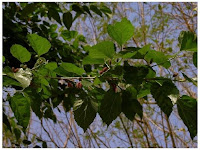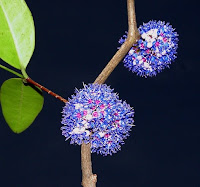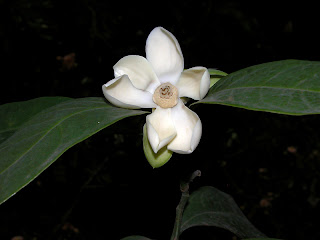
Ficus benghalensis

Artocarpus lakoocha

Morus alba

Morus alba

Artocarpus incisa
Broussonetia papyrifera
FAMILY OF THE WEEK : MORACEAE
A family of 53 genera and 1400 species, mostly in tropical and subtropical regions.In India the family is represented by 15 genera and 150 species occurring mostly in tropical and sub tropical Himalayas and Assam.
Vegetative characters :
They are mostly trees or shrubs or rarely herbs as in Dorstenia. Some species of Ficus climb on other trees with the help of aerial clasping roots.
Many species of Ficus produce aerial roots which form great pillars supporting the branches. The tree attains immense size.
The leaves are alternate, rarely opposite, simple, peni-or palminerved and stipulate. The stipules are caducous and leave a scar when they fall off. they are small and lateral or intra petiolar.
Ficus krishnae has a curious cup shaped leaves.
Inflorescences and flowers :
The small flowers are basically arranged in cym0ose inflorescences which form spikes,heads disks or hollow receptacles. In Morus the male flowers are arranged in Catkins and the female in pseudo spikes. In Artocarpus the male flowers are arranged in pseudo catkins and the female in pseudo heads. In ficus a very large number of flowers are born on the inner side of a hollowed out globose or pear shaped receptacle. It has a narrow apical orifice which is closed by a small overlapping bracts.There are three types of flowers male female and gall flowers the latter are sterile female flowers. The species of Ficus are monoecious or dioecious. In the former, all the three kinds of flowers are present in the same receptacle. In dioecious species the male and gall flowers are are born in the receptacle of one plant and the female flowers in the receptacles on the other plant.
Many species of Ficus are cauliflorus, bearing flowers on old parts of trunk, while several others are geocarpic fruiting on underground stolons which arise from the baes of the trunk.
The flowers are unisexual actinomorphic and hypogynous to epigynous.
The perianth consists of usually four persistent, free or more or less united tepals which are valvate or imbricate in bud. The stamens are usually four. Sometimes they are only one or two stamens as in Ficus and Artocarpus.The anthers are versatile, dithecous and opening lengthwise.
In the female flowers the gynoecium consists of basically two syncarpous carpels. The ovary is superior(Morus) or inferior(Dorstenia). unilocular with a solitary more or less curved ovule pendulous from the apex. The styles are mostly two and filiform.
Fruits and Seeds :
The fruit is an Achene(Ficus) or a drupe(Morus). The seeds are non endospermic or endospermic and generally with a curved embryo.
Pollination and seed dispersal :
The flowers of Morus and some genera are pollinated by wind. Ficus shows an extraordinary mode of pollination by a special gall wasp.
Examples:
Morus alba,nigra,macroura,laevigata,serrata Ficus largest genus with 800 species Ficus benghalensis L. Banyan,Wad Ficus religiosa (Peepal) Ficusramosa synFicus glomerulata(Gular) Ficus infectoria(Pilkhan)
Ficus virens Ficus krishnae Ficus elastca(Indian rubber tree)
Ficus carica(Fig Anjir)
Artocarpus altilis
Artocarpus incisa
Artocarpus lakoocha
Broussonetia papyrifera(Paper mulberry)















